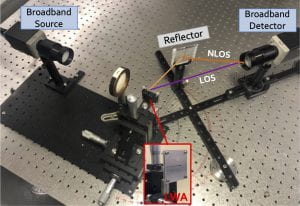New research addresses ‘link discovery’ problem for terahertz data networks
 When you open a laptop, an access point can quickly locate it and connect it to the local Wi-Fi network. That ability, known as link discovery, is a basic element of any wireless network, yet very challenging to accomplish in emerging terahertz bands. The challenge arises from the fact the terahertz links need to be directional to compensate for the significantly higher propagation attenuation. Hence, the access point should know where the clients are in order to aim its beam at them. Conventional solutions for this problem involve a brute-force trial-and-error scan of all beam directions; however, the time overhead associated with such exhaustive training severely degrades throughout and disrupts low-latency applications. More importantly, the direction of transmission needs to be continually adjusted as the client moves requiring repeated training and incurring overhead each time.
When you open a laptop, an access point can quickly locate it and connect it to the local Wi-Fi network. That ability, known as link discovery, is a basic element of any wireless network, yet very challenging to accomplish in emerging terahertz bands. The challenge arises from the fact the terahertz links need to be directional to compensate for the significantly higher propagation attenuation. Hence, the access point should know where the clients are in order to aim its beam at them. Conventional solutions for this problem involve a brute-force trial-and-error scan of all beam directions; however, the time overhead associated with such exhaustive training severely degrades throughout and disrupts low-latency applications. More importantly, the direction of transmission needs to be continually adjusted as the client moves requiring repeated training and incurring overhead each time.
The research introduces the first single-shot single-antenna link discovery technique that tracks user moves in nanosecond timescales in order to proactively adapt highly directional terahertz beams. We have proposed a novel node architecture in which the access point and clients are equipped with a leaky-wave antenna. This structure is composed of two metal plates with a space between them where radiation can propagate. One of the plates has a narrow slit cut into it, which allows radiation to leak out with the unique property that the emission angle from the waveguide is coupled to the frequency of the input signal.
We excite this antenna with a time-domain terahertz pulse (equivalently, a broadband signal in frequency-domain). Hence, different frequency components are decomposed and emerged at different angles, such that each direction has a unique spectral peak or “color” due to the leaky-wave antenna’s frequency-angle coupling. This forms a novel transmission pattern that we call a “Terahertz Rainbow” (see the picture above). Terahertz Rainbow enables scanning the entire space around the transmitter in nano-second-scale time and only via a single pulse transmission. Now imagine an access point equipped with a leaky-wave antenna and transmitting a terahertz rainbow. Depending upon where a client device is located relative to the access point, it’s going to see a different color coming out of the waveguide. The client just sends a signal back to the access point that says, “I saw yellow,” and now the access point knows exactly where the client is, and can continue tracking it. This technique allows for ultrafast adaptation, which is the key to achieving seamless connectivity.
This work is published in ACM MobiCom and Nature Communications 2020.